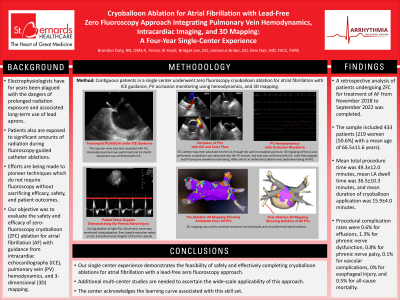Occupational/Radiation Safety
Cryoballoon Ablation for Atrial Fibrillation with Lead-Free Zero Fluoro Approach: A Four-Year Single-Center Experience

Purpose: Electrophysiologists have for years been plagued with the dangers of prolonged radiation exposure and associated long-term use of lead aprons. Patients also are exposed to significant amounts of radiation during fluoroscopy-guided catheter ablations. Our aim is to evaluate the acute safety and efficacy of zero fluoroscopy cryoballoon ablation (ZFC) for atrial fibrillation (AF) with guidance from intracardiac echocardiography (ICE), pulmonary vein (PV) hemodynamics, and 3-dimensional (3D) mapping.
Material and Methods: Contiguous patients in a single center underwent ZFC for AF with ICE guidance, PV occlusion monitoring using hemodynamics, and 3D mapping. The superior vena cava was visualized with ICE, transseptal puncture was performed and LA sheath placement was confirmed with ICE. ICE catheter was then advanced into the LA through the same transseptal puncture. 3D mapping of the LA was performed, cryoballoon was advanced into the PV antrum, and seal was confirmed with ICE, color-flow doppler, and PV pressure waveform monitoring. Wide antral circumferential ablation was performed along all PVs. During ablation of right PVs, the phrenic nerve was monitored using palpation, liver capsule excursion noted on ICE, and pulsed wave doppler of the liver capsule. 3D mapping was used to ascertain entrance and exit blocks and circumferential antral isolation.
Results: A retrospective analysis of patients undergoing ZFC for treatment of AF from November 2018 to September 2022 was completed. The sample included 433 patients (219 women [50.6%] with a mean age of 66.5±11.6 years). Mean total procedure time was 49.3±12.0 minutes, mean LA dwell time was 36.5±10.3 minutes, and mean duration of cryoballoon application was 15.9±4.0 minutes. Procedural complication rates were 0.6% for effusions, 1.3% for phrenic nerve dysfunction, 0.8% for phrenic nerve palsy, 0.1% for vascular complications, 0% for esophageal injury, and 0.5% for all-cause mortality.
Conclusions: Our single center experience demonstrates the feasibility of safely and effectively completing cryoballoon ablations for atrial fibrillation with a lead-free zero fluoroscopy approach. Additional multi-center studies are needed to ascertain the wide-scale applicability of this approach. The center acknowledges the learning curve associated with this skill set.
Material and Methods: Contiguous patients in a single center underwent ZFC for AF with ICE guidance, PV occlusion monitoring using hemodynamics, and 3D mapping. The superior vena cava was visualized with ICE, transseptal puncture was performed and LA sheath placement was confirmed with ICE. ICE catheter was then advanced into the LA through the same transseptal puncture. 3D mapping of the LA was performed, cryoballoon was advanced into the PV antrum, and seal was confirmed with ICE, color-flow doppler, and PV pressure waveform monitoring. Wide antral circumferential ablation was performed along all PVs. During ablation of right PVs, the phrenic nerve was monitored using palpation, liver capsule excursion noted on ICE, and pulsed wave doppler of the liver capsule. 3D mapping was used to ascertain entrance and exit blocks and circumferential antral isolation.
Results: A retrospective analysis of patients undergoing ZFC for treatment of AF from November 2018 to September 2022 was completed. The sample included 433 patients (219 women [50.6%] with a mean age of 66.5±11.6 years). Mean total procedure time was 49.3±12.0 minutes, mean LA dwell time was 36.5±10.3 minutes, and mean duration of cryoballoon application was 15.9±4.0 minutes. Procedural complication rates were 0.6% for effusions, 1.3% for phrenic nerve dysfunction, 0.8% for phrenic nerve palsy, 0.1% for vascular complications, 0% for esophageal injury, and 0.5% for all-cause mortality.
Conclusions: Our single center experience demonstrates the feasibility of safely and effectively completing cryoballoon ablations for atrial fibrillation with a lead-free zero fluoroscopy approach. Additional multi-center studies are needed to ascertain the wide-scale applicability of this approach. The center acknowledges the learning curve associated with this skill set.
